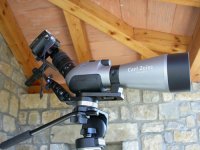RonR
Active member
I had an opertunity to visit with an Ziess representitive at a sports show, what an experience, did not get his name as I was to busy learning. Being I have a Sony F707 I wanted to see what could be done with the Zeiss - was working with the 65 and it did a very good job, being we were inside and not much to focus on, we used a barcode on another exibitors stock, recommended I get to a dealer an try the 85 and wait till Zeiss comes out with the mount for the Sony - he told me how it would operate and it sounded like it would be the "cats meow".
We'll wait and see.
We'll wait and see.





